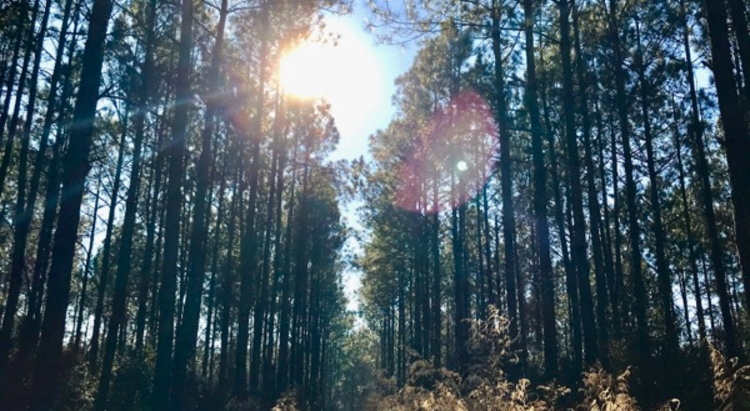The Kendeda Building was designed to be a model of regenerative design in the Southeast, showing people what’s possible. Inherent in this goal is the notion that building construction and operations can restore regional ecosystems; much has been written on Kendeda Building’s approach to stormwater, for example.
While there are many ways regenerative design can have an impact, few have as broad an influence across the Southeast as wood sourcing. Salvage wood has been a key part of the project, but the Living Building Challenge requires all new wood to be Forest Stewardship Council certified. FSC’s mission is to promote environmentally sound, socially beneficial and economically prosperous management of the world’s forests, with members that include World Wildlife Fund, Greenpeace, Kimberly-Clark, International Paper and many others. (Full disclosure: As a communications consultant, I do work for FSC.)
To understand some of the impact of FSC sourcing, we followed the supply chain for the Kendeda Building’s dimensional lumber back to the forest of origin in Alabama.
From coastal plains on the Gulf of Mexico to the Appalachians of West Virginia, forests cover more than 130,000 square miles of the Southeast. One of the region’s nicknames is “the world’s wood basket.” So sourcing lumber from the Southeast was a natural priority for the design and construction team of the mass-timber building.
For dimensional lumber in the project, including all new wood used in the iconic flooring system, our story starts in the forests surrounding Moundville, Ala. — home to the Westervelt Co. lumber mill. As an integrated company, Westervelt owns and manages forestlands in the United States and New Zealand, with a second mill under development in Thomasville, Ala.
The company’s 440,000 acres of FSC-certified forest in Alabama is where the dimensional lumber in the Kendeda Building started its life. As is common in the Southeast, much of the forest is managed for loblolly pine – the species used in the building. However, unlike many other forest managers, Westervelt also prioritizes management on select sites for the majestic longleaf pine – Alabama’s state tree, now reduced to less than 5 percent of its historical range. This means the company uses prescribed burning to reduce understory competition and support the fire-resistant species that once dominated the coastal plain.
“We let the site dictate what needs to be growing there,” says Jonathan Lowery, Westervelt’s sustainability and policy director.
The need for prescribed burns has been increasing as the risk of wildfire increases in the region.
“With a changing climate and less prescribed fire on the landscape, we are monitoring the potential for increasing wildfire risk in the region,” said Lowery. “These trends highlight the need for greater understanding of climate and fire impacts and the importance of responsible forest management such as is seen on FSC certified lands.”
Another requirement for FSC certification is protection for High Conservation Value forests, which are globally, regionally or nationally significant for environmental or social reasons. Examples include rare old-growth forests or important cultural sites for Indigenous People. In Westervelt’s forests, 1,250 acres are protected as threatened gopher tortoise habitat, and for conservation of dolomite glades and chalk prairie, two rare ecosystems in Alabama. Nearly 3,000 additional acres are protected as representative intact forest landscapes along two creeks and the Alabama River.
As a market-based approach, FSC relies on demand from companies and consumers for the system to work. In the case of the Kendeda Building, UFP International was the FSC-certified distributor that provided the wood package to the project. “We were excited about the project from day one,” said Laura Ebersberger, account manager for UFP. “The size request and the volume took some preparation,” she added.
The design team requested that the wood have “character” to provide a rustic look, which meant collecting pieces with more knots and visual appeal, albeit with the same structural strength. In any case, it is important to include plenty of lead time when sourcing FSC-certified wood, as availability can vary by market, time of year, and product. “We find great value in being able to provide FSC to our customers,” noted Ebersberger.
One of those customers is Jimmy Mitchell, director of project solutions at Skanska USA and a lead on the Kendeda Building. “It was great to find a partner in UFP who had kept its FSC certification and had leaders in the industry ready to go,” Mitchell noted.
From the outset, one goal of the Kendeda Building was to reduce embodied carbon in the materials selected. “Mass timber was one of the key goals; picking the wood is about lowering embodied carbon,” said Mitchell.
While interest in mass timber has grown significantly, its rollout in the Southeast has been slow. Mitchell indicated the COVID-19 pandemic hasn’t helped because it resulted in a few mass timber projects in the region being put on hold. Still, he remains optimistic.
“If architects and structural engineers are successful in convincing their clients,” he said, “then it will come.”
“From a climate standpoint, there does seem to be good recognition that this might make sense compared to steel and concrete, if you can keep that land in forests, keep forests as forests,” noted Lowery. Eighty-six percent of forestland in the Southeast is privately owned, most by families or individuals. So by using FSC-certified wood in its construction, the Kendeda Building rewarded landowners for meeting high standards for forest management. And in doing so, the project helped advance its goal of regenerating regional economies and ecosystems.
PHOTO AT TOP: Westervelt owns and manages this sustainably managed loblolly pine plantation in Alabama. Photo courtesy of Westervelt.
Brad Kahn is communications consultant based in Seattle, Washington. His practice focuses on climate, forests and green building, with clients including the Forest Stewardship Council, David and Lucile Packard Foundation, International Living Future Institute, and Kendeda Fund. He has a Master’s degree in watershed systems and management from the Yale School of Forestry and Environmental Studies.


